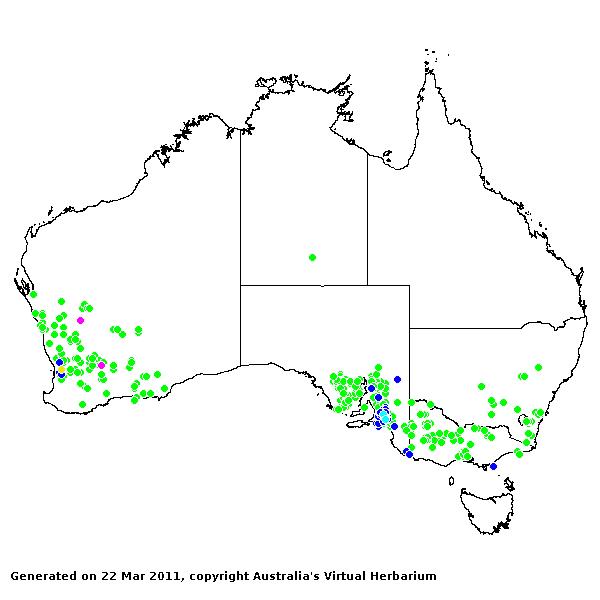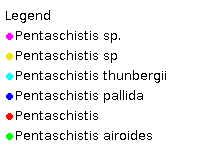Pentameris* Hist. Nat. Veg. Phan. 13: 164 (1846).
Derivation:. From the Greek pente (five) and schistos (split, cut), alluding to the cleft lemmas.
Key references (keys and floras):. C.A.Gardner, Flora of Western Australia 1 Gramineae 52–54 (1952); J.P.Jessop, Flora of South Australia 4: 1866–1867 (1986); B.K.Simon, Key to Australian Grasses 143 (1993); S.W.L.Jacobs and K.L.McClay, Flora of New South Wales 4: 548 (1993); N.G.Walsh, Flora of Victoria 2: 524–5251 (1994); D.Sharp and B.K.Simon, AusGrass (2002); K.Mallet (ed.), Flora of Australia 44B: Poaceae 3: 26–27 (2005); J.P.Jessop, Grasses of South Australia 306–307 (2006); S.W.L.Jacobs, R.D.B.Whalley & D.J.B.Wheeler, Grasses of New South Wales, 4th ed, 335–336 (2008).
W.D.Clayton & S.A.Renvoize, Genera Graminum (1986), genus (268).
Naturalised. About 65 species, from Africa, Madagascar. 2 species in Australia, WA, SA, NSW, and Vic.
Habit. Perennial (usually) or annual (less commonly), ususlly tufted. Leaf blades narrow. Ligule a fringe of hairs.
Inflorescence. Inflorescence paniculate (the branches often with glands).
Spikelets. Spikelets laterally compressed, 2 flowered to more than 2 flowered, pedicelled; with naked rachilla extension (as a minute bristle, or with a rudimentary third floret), or with rachilla terminating in a floret. Fertile spikelets laterally compressed, disarticulating above glumes.
Glumes. Glumes more or less equal, about equal to spikelet to exceeding florets, long relative to adjacent lemmas (enclosing the spikelet), hairy or hairless, glabrous, pointed, awnless, keeled, similar (narrow to lanceolate, green or scarious, rarely hyaline, shining, often with glands). Lower glume 1 nerved (above the base). Upper glume 1 nerved (above the base).
Florets. Fertile florets 2. Lemmas similar in texture to glumes (membranous), incised (bifid, rarely 3–4-fid), muticous or mucronate or awned (generally awned from the central sinus, and with a point or straight awn on each lobe), without a germination flap, 5–7 nerved, with nerves non-confluent, not keeled (dorsally rounded). Awns when present, 1 (rarely) or 3 (usually) or 5 (rarely), the median different in form from laterals (when laterals present), from a sinus, usually geniculate, hairless, much longer than body of lemma. Lateral awns when present, shorter than median (straight, inserted in the sinuses and partially fused to the lateral lemma lobes). Palea relatively long, tightly clasped by lemma, apically notched, textured like lemma, 2 nerved (but with the nerves not reaching the apex of the palea), 2 keeled (with the keels very poorly developed). Palea keels wingless, glabrous. Distal incomplete florets underdeveloped. Callus short, blunt. Lodicules 2. Stamens 3. Stigmas 2. Grain small, golden-brown, ellipsoid, longitudinally grooved, glabrous. Hilum short (but linear-oblong). Embryo large to small (up to a third of the grain length).
Kranz Anatomy. C3.
2n = 14, 26, 28, 42, and 52, commonly adventive.
Habitat. Mesophytic to xerophytic. Species of open habitats.
Classification. Danthonioideae.
Notes. A member of the Pentaschistis clade (Pentaschistis, Pentameris, Prionanthium) of the danthonioid grasses (GPWG, 2001).
Types Species. P. curvifolia (Schrad.) Stapf.
Biogeographic Element. Clifford & Simon 1981, Simon & Jacobs 1990: Naturalised.


